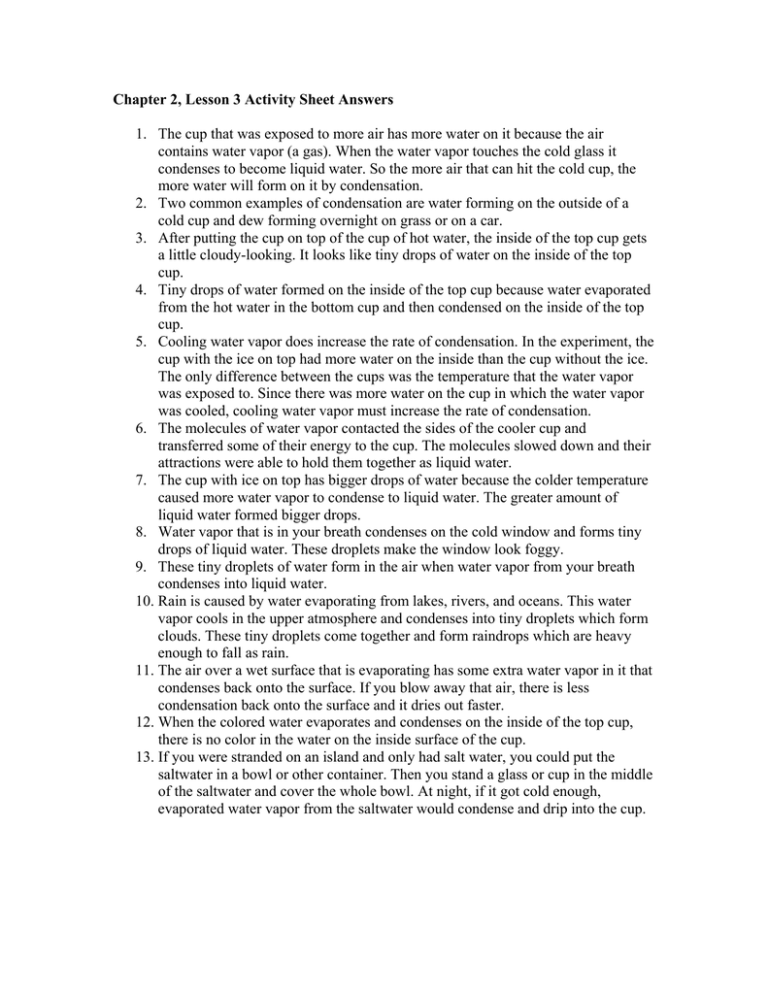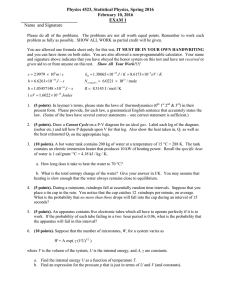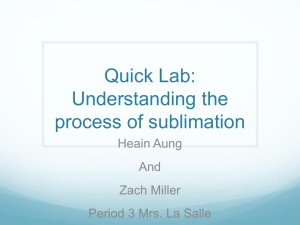Chapter 2, Lesson 3 Activity Sheet Answers
advertisement

Chapter 2, Lesson 3 Activity Sheet Answers 1. The cup that was exposed to more air has more water on it because the air contains water vapor (a gas). When the water vapor touches the cold glass it condenses to become liquid water. So the more air that can hit the cold cup, the more water will form on it by condensation. 2. Two common examples of condensation are water forming on the outside of a cold cup and dew forming overnight on grass or on a car. 3. After putting the cup on top of the cup of hot water, the inside of the top cup gets a little cloudy-looking. It looks like tiny drops of water on the inside of the top cup. 4. Tiny drops of water formed on the inside of the top cup because water evaporated from the hot water in the bottom cup and then condensed on the inside of the top cup. 5. Cooling water vapor does increase the rate of condensation. In the experiment, the cup with the ice on top had more water on the inside than the cup without the ice. The only difference between the cups was the temperature that the water vapor was exposed to. Since there was more water on the cup in which the water vapor was cooled, cooling water vapor must increase the rate of condensation. 6. The molecules of water vapor contacted the sides of the cooler cup and transferred some of their energy to the cup. The molecules slowed down and their attractions were able to hold them together as liquid water. 7. The cup with ice on top has bigger drops of water because the colder temperature caused more water vapor to condense to liquid water. The greater amount of liquid water formed bigger drops. 8. Water vapor that is in your breath condenses on the cold window and forms tiny drops of liquid water. These droplets make the window look foggy. 9. These tiny droplets of water form in the air when water vapor from your breath condenses into liquid water. 10. Rain is caused by water evaporating from lakes, rivers, and oceans. This water vapor cools in the upper atmosphere and condenses into tiny droplets which form clouds. These tiny droplets come together and form raindrops which are heavy enough to fall as rain. 11. The air over a wet surface that is evaporating has some extra water vapor in it that condenses back onto the surface. If you blow away that air, there is less condensation back onto the surface and it dries out faster. 12. When the colored water evaporates and condenses on the inside of the top cup, there is no color in the water on the inside surface of the cup. 13. If you were stranded on an island and only had salt water, you could put the saltwater in a bowl or other container. Then you stand a glass or cup in the middle of the saltwater and cover the whole bowl. At night, if it got cold enough, evaporated water vapor from the saltwater would condense and drip into the cup.





